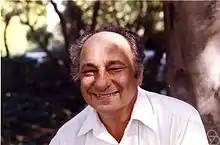Lowell Schoenfeld
Lowell Schoenfeld (April 1, 1920 – February 6, 2002) was an American mathematician known for his work in analytic number theory.
Lowell Schoenfeld | |
|---|---|
 | |
| Born | April 1, 1920 |
| Died | February 6, 2002 (aged 81) |
| Nationality | American |
| Alma mater | University of Pennsylvania |
| Scientific career | |
| Fields | Mathematics |
| Thesis | A Transformation Formula in the Theory of Partitions (1944) |
| Doctoral advisor | Hans Rademacher |
| Doctoral students | Samuel Lawn |
Career
Schoenfeld received his Ph.D. in 1944 from University of Pennsylvania under the direction of Hans Rademacher.
In 1953, as an assistant professor at the University of Illinois Urbana-Champaign, he married (as his second wife) associate professor Josephine M. Mitchell, causing the university to fire her from her tenured position under its anti-nepotism rules while allowing him to keep his more junior tenure-track job. They both resigned in protest, and after several short-term positions they were both able to obtain faculty positions at Pennsylvania State University in 1958.[1] They were both promoted to full professor in 1961, and moved to the University at Buffalo in 1968.[2]
Contributions
Schoenfeld is known for obtaining the following results in 1976, assuming the Riemann hypothesis:
for all x ≥ 2657, based on the prime-counting function π(x) and the logarithmic integral function li(x), and
for all x ≥ 73.2, based on the second Chebyshev function ψ(x).[3]
References
- Rossiter, Margaret W. (1995), Women Scientists in America: Before Affirmative Action, 1940–1972, Johns Hopkins University Press, pp. 125–126, ISBN 9780801857119
- "Josephine M. Mitchell, UB Math Professor", Buffalo News, December 31, 2000
- ——— (1976), "Sharper Bounds for the Chebyshev Functions θ(x) and ψ(x). II", Mathematics of Computation, 30 (134): 337–360, doi:10.2307/2005976, JSTOR 2005976.